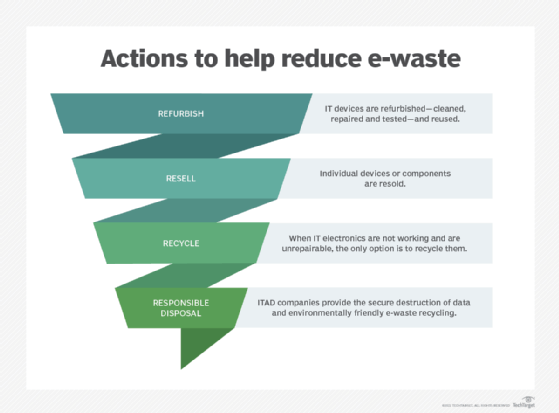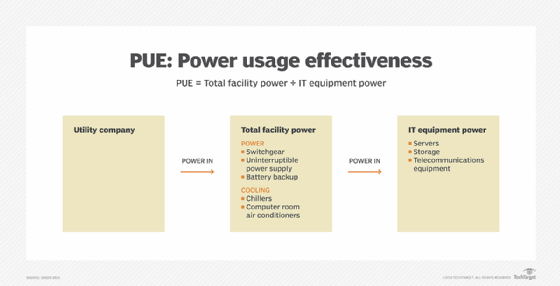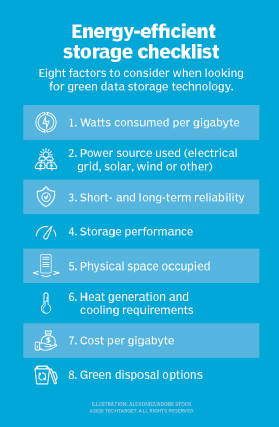What is a green data center?
A green data center is a repository for the storage, processing, management and dissemination of data in which the physical space and the mechanical and electrical subsystems are designed to maximize energy efficiency and minimize the environmental impact. The construction and operation of a green data center includes advanced technologies and strategies.
The following are examples of some of the technologies and strategies used in green data center initiatives:
- Minimized building footprints with physical spaces optimized for effective airflow.
- Low-emission building materials, carpets and paints.
- Sustainable landscaping.
- Extensive use of virtualization to maximize hardware utilization while reducing space and heat generation.
- Use of AI platforms to analyze data center operations and optimize data center infrastructure management (DCIM) techniques.
- E-waste recycling.
- Catalytic converters on backup generators.
- Alternative cooling technologies, including heat pumps, evaporative cooling, natural cooled facilities located in cold geographic locations and liquid immersion cooling for servers and other computing equipment.
- Heat recovery and redirection designs that redirect and reuse heat from data center facilities to other cooler areas of the building.
- Alternative and renewable energy sources, such as photovoltaic technology, biofuels and wind technology.
- Hybrid and electric vehicles.
Building and certifying a green data center or other facility can be expensive upfront, but long-term cost savings can be realized on operations and maintenance. Green facilities offer employees a healthy, comfortable work environment and enhance relations with local communities.
Environmentalists and, increasingly, the general public are pressuring governments to offer green incentives. Companies sometimes receive tax incentives and other monetary support for the development and use of environmentally responsible technologies.
Why do you need a green data center?
Green data centers have become essential for enterprise computing. A properly designed and well-implemented green data center design can use a range of energy-efficient technologies to do the following:
- Lower power consumption, which is one of the largest data center expenses.
- Reduce carbon emissions, which demonstrates environmental responsibility, improves public brand perception and helps the environment.
- Conserve valuable resources, such as water and fossil fuels.
- Improve the sustainability of data center operations, which is a critical concern for business continuity.
Establishing a green data center can be complex and expensive. Traditional data centers can be upgraded or retrofitted with green technologies, such as virtualization, AI-driven DCIM, and refurbishing and recycling programs. However, the deployment of a full-service green data center with a comprehensive suite of green technologies and strategies typically requires the construction of a new data center facility.
What are the benefits of a green data center?
Adopting a green approach to data center energy and environment management is a significant investment. However, over time, these data centers provide a range of advantages. Some benefits of green data centers are the following:
- Lower long-term operating costs.
- Reduced physical space requirements.
- Less carbon emissions and a smaller carbon footprint due to fewer and more energy-efficient data center gear.
- Decreased water use, expanding the range of suitable data center locations while reducing contention for water with local communities.
- Reduced waste output from packaging reductions, gear redeployments and recycling.
- Enhanced business continuity and regulatory compliance postures.
- Reduced electricity consumption.
- More emphasis on renewable and sustainable data center technology and resources.

Green data center performance metrics
Numerous metrics have been developed to measure energy use and sustainability. They help demonstrate and certify that buildings are using energy efficiently and don't harm the environment. Organizations typically adopt and track several green energy metrics to provide the most complete picture of energy efficiency and sustainable practices and operation.
- Power usage effectiveness. Developed in 1997 by The Green Grid, part of the Information Technology Industry Council, PUE measures the power consumption of a data center. It's the ratio of the total power provided to the data center divided by the power the IT equipment in the data center uses. The goal is to have the ratio come as close as possible to one. A ratio of one means all of the power provided to the data center is being used by the computing equipment, effectively eliminating heat and waste. Ratios greater than one indicate lower efficiency.
- Data center Infrastructure efficiency. DCiE measures how effectively a data center uses the available infrastructure. It divides the power consumed by IT gear by the total power the data center uses. DCiE is the inverse of PUE. A DCiE approaching one indicates greater energy efficiency. As with PUE, DCiE is a direct gauge of efficiency and is often used to help engineers measure the impact of infrastructure changes on efficiency.
- Carbon usage effectiveness. The Green Grid also developed the CUE metric to show if a data center has attained its sustainability goals. It's the ratio of carbon dioxide emissions the data center generates divided by the energy consumption of data center equipment. The goal is to have the lowest possible value, which indicates that the data center is effectively controlling its carbon dioxide emissions and carbon footprint.
- Water usage effectiveness. The WUE metric evaluates a data center's water consumption relative to its energy output. It's determined by dividing the total annual water use in liters by the total annual energy use in kilowatt-hours. The result is WUE expressed in liters per kWh. WUE is most useful for facilities that rely on water-based cooling systems.
- Renewable energy usage. REU is the ratio of energy derived from renewable sources, including photovoltaic, wind and hydroelectric power, divided by the total electricity used by the data center. This renders a ratio, but REU is typically expressed as a percentage. When the REU reaches 100%, all of the facility's energy use is from renewable sources. REU is most helpful for green data centers that emphasize sustainability through renewable energy sources.
- Energy reuse factor. ERF is a more exotic metric that expresses energy efficiency in terms of re-use. ERF is a ratio of the energy re-used, such as using waste heat from servers to heat other spaces, versus the total energy the data center uses. This ratio is expressed as a percentage, and is typically low, but larger percentages indicate more effective energy reuse.
- Data center carbon footprint. The DCCF metric gauges the environmental impact of a data center. It's determined by multiplying the total power the data center consumes by the carbon emission factor of the power source. A lower DCCF means a lower carbon impact. Engineers often use this metric to determine the sustainability of the data center and as justification for investments in renewable, low-carbon emission energy sources.

Energy efficiency certifications
Three certifications are available to validate that a building or IT device is energy-efficient and environmentally friendly:
- Leadership in Energy and Environmental Design. The U.S. Green Building Council created this certification. LEED certification of a building means it has satisfied a rigorous set of criteria to reduce energy consumption and be environmentally friendly.
- Energy Star. Developed by the U.S. Environmental Protection Agency and the U.S. Department of Energy, the Energy Star designation certifies that a machine or device is energy-efficient. Use of Energy Star-certified products have saved residential and businesses users more than 5 trillion kilowatts of electricity since 1992.
- Certified Energy Efficient Datacenter Award. CEEDA is a certification framework designed around a mix of standards, including ones from the American Society of Heating, Refrigerating, and Air Conditioning Engineers; Energy Star; the European Code of Conduct; European Telecommunications Standards Institute; Green Grid metrics; and the International Organization for Standardization. This global certification program independently recognizes the successful implementation of energy-efficiency practices in data centers across a variety of specialized disciplines.
Components of a green data center
Virtually every component of a data center, from how the building is constructed to the equipment in use, can be made more energy-efficient and environmentally friendly.

Energy efficiency and environmental considerations are essential design components when upgrading an existing data center or building a new one. Organizations planning a green data center can use a design firm with experience in designing energy-efficient and environmentally friendly buildings.
Design considerations and components of a green data center include the following:
- Cold and hot aisles. Data center servers are placed and contained in cold and hot aisles that enable hot air to be pumped to air conditioner returns and cold air from cold aisles to where it's needed for cooling.
- Free air cooling. Free cooling systems use outdoor air to cool data centers that are strategically located in cooler climates.
- Liquid cooling. Immersion cooling technologies submerge data center gear in a circulated bath of nonconductive oil that contains and carries heat more efficiently than air cooling while using less power in chiller and circulation equipment than traditional heating, ventilation and air conditioning gear.
- Low-power servers. These servers work well in data centers. Their low energy consumption makes them more efficient than traditional servers.
- Virtualized servers. Virtualization lets a single physical server host multiple virtual server instances. One physical server can function as many different servers and reduce the total server count in the data center.
- Modular data centers. These energy-efficient data centers are portable and can be quickly set up wherever they're needed. They're also called data centers in a box.
- Evaporative cooling. Various technologies, such as evaporation pads and high-pressure spray systems, reduce heat through the evaporation of water.
- Heat recovery and reuse. Waste heat from data center power use is reused to heat other facilities.
- Ultrasonic humidification. Energy-efficient ultrasound is used to create the moisture needed to establish proper environmental conditions to run some devices in a data center. For example, adequate humidity reduces static accumulation and potentially damaging static discharges.
- Renewable energy use. Green data centers will typically integrate one or more renewable energy sources, such as photovoltaic, wind, hydroelectric or biofuel installations. This reduces their carbon footprint, improves sustainability and reduces dependence on traditional utilities.
- Infrastructure monitoring and management. Software technologies such as DCIM let data center operators monitor energy use, optimize resource allocation, ensure safe operational environments, and oversee facility and IT infrastructure performance.
- Building design. Factors such as building size and positioning, insulation type, natural lighting and air handling can reduce ongoing energy demands and affect data center efficiency.
Cloud computing and green data centers
The global rise of cloud computing has altered the calculus of green data center design and implementation for many organizations. In effect, cloud computing allows an organization to use computing resources and services remotely and on demand. This treats computing as if it were a utility such as electricity or water.
For most organizations, the availability of cloud computing has reduced, and even eliminated, the demand for green data center design. Cloud computing mitigates issues such as hardware counts, power supply and use, cooling needs and physical space.
For example, an organization might opt to migrate key workloads and data to a cloud provider rather than invest the time, financial capital and personnel in building and operating a green data center. Some of the most progressive businesses might forego a data center entirely and commit to a cloud-first or cloud-native posture for their business software and services.
However, for cloud computing providers with many large data centers around the world, the need to design, build and manage green data centers is more acute than ever.
Learn more about what factors to consider to run a sustainable data center.






